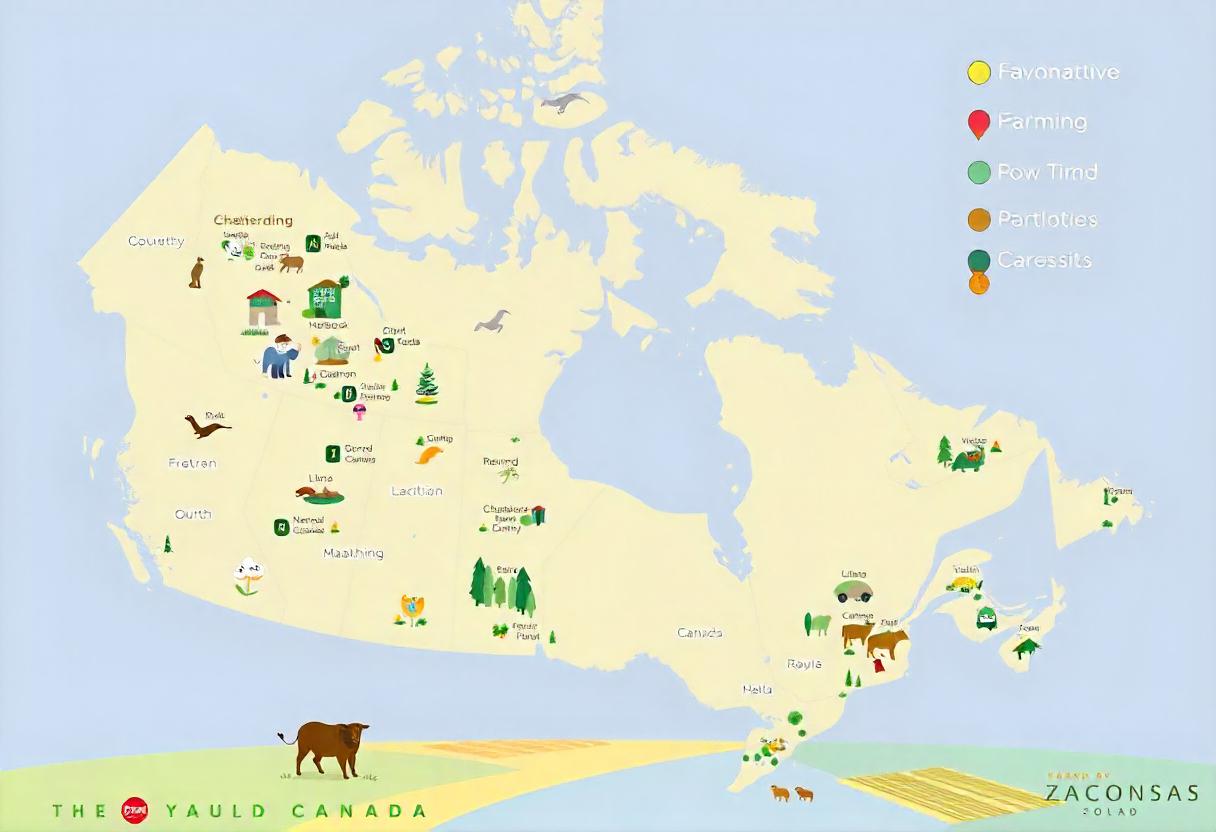
Farming is an essential industry in Canada, shaped by the country’s diverse landscapes, climates, and economic needs. Across its vast territory, each province has developed unique agricultural practices based on regional characteristics. From the expansive grain farms of the Prairies to the specialized vineyards of British Columbia, farming in Canada is varied and deeply connected to the local environment. This article provides an in-depth look at farming in Canada by province, highlighting the key agricultural sectors, challenges, and contributions of each region.
1. Alberta
Alberta is one of Canada’s agricultural powerhouses, known for its large-scale grain, oilseed, and livestock production. The province’s vast prairies, rich soil, and favorable growing conditions make it ideal for farming. Key agricultural products include wheat, barley, canola, and beef. Alberta is the country’s largest beef producer, supplying about 40% of Canada’s beef.
Challenges and Opportunities
Alberta’s farmers face challenges such as fluctuating commodity prices and climate change, which can result in droughts or severe weather conditions. However, the province’s well-developed agricultural infrastructure, including extensive irrigation systems, supports continued growth and innovation in farming practices.
2. Saskatchewan
Saskatchewan is often referred to as Canada’s breadbasket due to its significant contribution to the country’s grain production. The province is a global leader in the production of wheat, canola, and pulses (such as lentils and peas). Saskatchewan’s flat terrain and fertile soil create ideal conditions for large-scale farming operations.
Challenges and Opportunities
Like Alberta, Saskatchewan faces challenges from weather variability and global market fluctuations. However, the province continues to innovate, with farmers adopting advanced technologies like precision farming and exploring sustainable agricultural practices to improve yields and reduce environmental impacts.
3. Manitoba
Manitoba is another key player in Canada’s agricultural sector, producing a wide range of crops, including wheat, canola, and sunflowers, as well as livestock and dairy products. The province’s diverse climate and soil types allow for a variety of farming activities, from grain and oilseed production to livestock farming and specialty crops.
Challenges and Opportunities
Manitoba’s farmers face challenges such as extreme weather conditions, including floods and droughts. However, the province is investing in agricultural research and development to help farmers adapt to climate change and improve crop resilience.
4. Ontario
Ontario is Canada’s most populous province and a major hub for agricultural production. It is the country’s leading producer of fruits, vegetables, and dairy products. Southern Ontario’s fertile soils and moderate climate support a diverse range of crops, including corn, soybeans, apples, and grapes. The province is also known for its wine industry, particularly in the Niagara region.
Challenges and Opportunities
Ontario’s farmers face challenges related to land costs, urbanization, and environmental regulations. However, the province’s proximity to major markets in Canada and the United States provides significant opportunities for agricultural exports and value-added products.
5. Quebec
Quebec is a leading producer of dairy products, accounting for nearly half of Canada’s total dairy production. The province is also known for its maple syrup industry, producing over 90% of the world’s supply. Quebec’s agricultural sector is diverse, with farmers growing grains, fruits, and vegetables and raising livestock.
Challenges and Opportunities
Quebec’s farmers must navigate challenges such as harsh winters and the high cost of farm inputs. However, the province’s strong agricultural policies, including support for dairy farming through supply management, help maintain the profitability and sustainability of its farming sector.
6. British Columbia
British Columbia’s diverse geography and climate allow for a wide range of agricultural activities, from fruit and vegetable production to livestock farming and viticulture. The province is known for its orchards, vineyards, and berry farms, particularly in the Okanagan Valley. B.C. is also a major producer of greenhouse vegetables, such as tomatoes and peppers.
Challenges and Opportunities
British Columbia’s farmers face challenges related to land costs, water availability, and climate change. However, the province’s unique growing conditions allow for the production of high-value crops, such as wine grapes and organic produce, which can command premium prices in the market.
7. Atlantic Provinces (New Brunswick, Nova Scotia, Prince Edward Island, Newfoundland and Labrador)
The Atlantic provinces have a rich agricultural history, with farming playing a significant role in the region’s economy. Prince Edward Island (P.E.I.) is renowned for its potato production, while Nova Scotia is known for its apple orchards and vineyards. New Brunswick produces a variety of crops, including potatoes, blueberries, and dairy products, while Newfoundland and Labrador’s agricultural sector is smaller but growing, with an emphasis on livestock and greenhouse production.
Challenges and Opportunities
The Atlantic provinces face challenges such as limited growing seasons, small land bases, and the impact of climate change. However, the region’s focus on high-quality, niche products—such as organic produce, artisanal cheeses, and specialty crops—offers opportunities for growth in domestic and export markets.
8. Northern Territories (Yukon, Northwest Territories, Nunavut)
Agriculture in Canada’s northern territories is relatively small in scale due to the harsh climate and limited arable land. However, there is growing interest in local food production to reduce reliance on imported goods. Farmers in the North are experimenting with greenhouse production, small-scale livestock farming, and innovative techniques to extend growing seasons.
Challenges and Opportunities
Northern farmers face significant challenges related to climate, soil quality, and transportation. However, the increasing demand for locally grown food in northern communities provides opportunities for agricultural expansion and the development of unique farming practices suited to the northern environment.
Farming in Canada is as diverse as the country itself, with each province and territory contributing to the nation’s agricultural success. From the vast grain fields of the Prairies to the specialized farms of the Atlantic provinces and the North, Canadian farmers are resilient and innovative, adapting to the unique challenges and opportunities presented by their environments. As the industry continues to evolve, Canadian agriculture will remain a vital part of the national economy, providing food, jobs, and economic stability across the country.